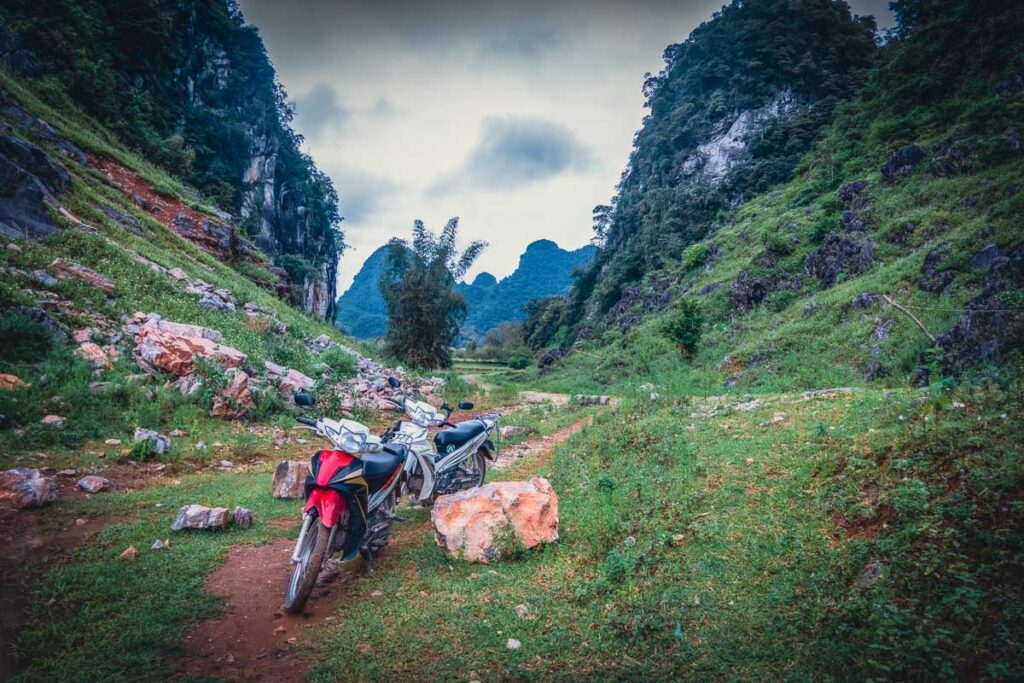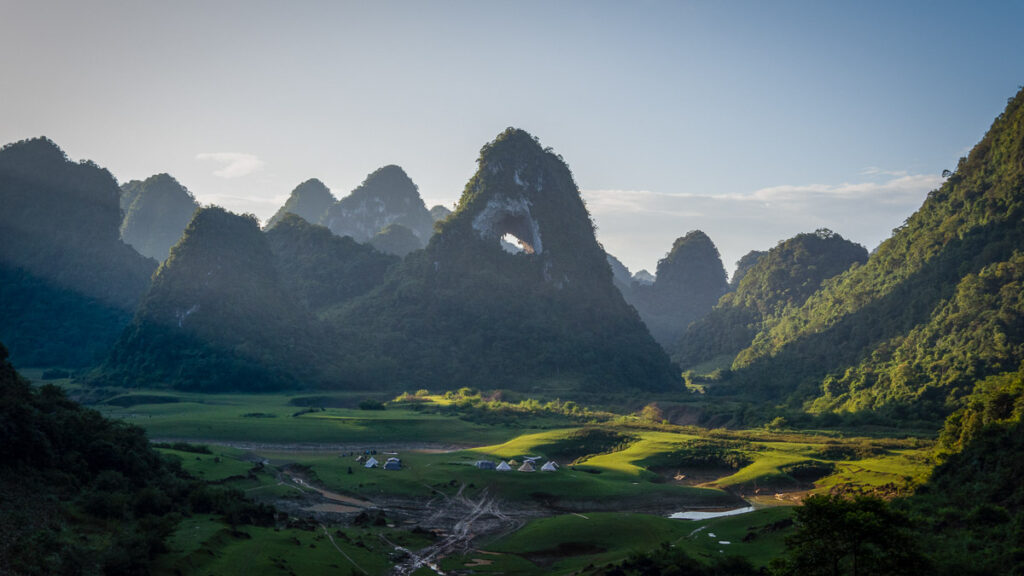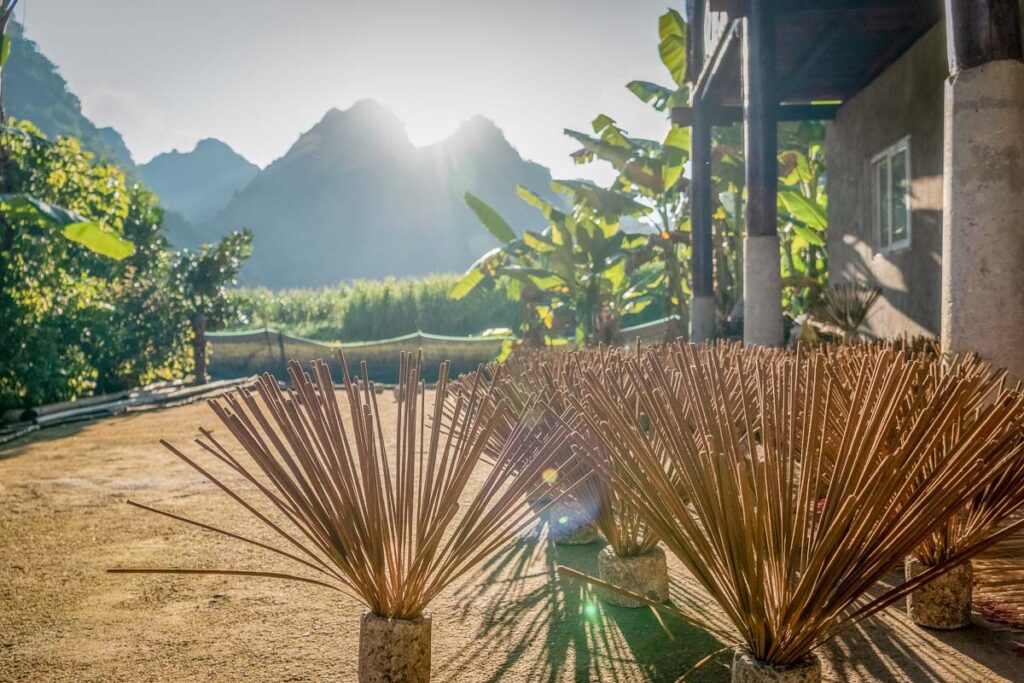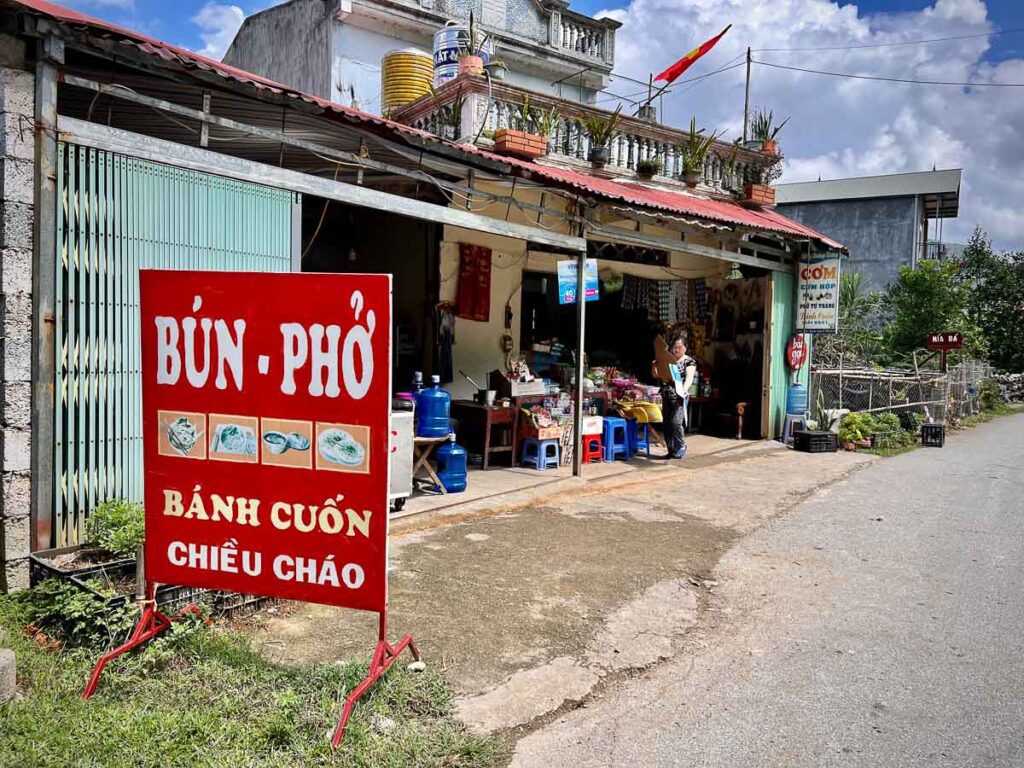Why Cao Bang, Vietnam, Should Be on Every Adventurer’s Bucket List

Cao Bang, Vietnam, tucked in the northeastern corner close to the Chinese border, may not often be on the itineraries of most first-time visitors. Far from the capital, Hanoi, most tourists go straight to more well-known places like Ha Long Bay, Ha Giang Loop, and Sapa. However, If you’re looking for an off-the-beaten-path adventure, it’s hard to beat Cao Bang, Vietnam’s stunning surrounding area.
IS Cao Bang Worth Visiting?
Actually named a UNESCO World Heritage Site, a large portion of this mountainous border province is named the Non Nuoc Cao Bang Geopark. It’s most well-known as the home of Ban Gioc waterfall – one of Vietnam’s most beautiful landmarks and the largest waterfall in all of Asia.
Not only that, but the mountain ranges in this region are begging to be explored. Lose yourself hiking, biking, or taking scenic drives all along the valleys around this North Vietnam hidden gem. Come and find out the can’t miss adventurous things to do around Cao Bang, Vietnam!

How to Get to Cao Bang
Hanoi to Cao Bang by Public Transportation
No train lines cross from Hanoi over the mountainscapes to Cao Bang. The best option to arrive at Cao Bang from Hanoi is to take the 7-8 hour night bus that costs between 300K-500K VND ($12.50-$21 USD).
The cheaper ticket prices will get you on a small sleeper bus seat that reclines, but don’t expect sizeable seating. On the higher end, you can get the “limo” sleeper buses with exaggerated recline, outlet chargers, and generally more comfort.
Rent a Motorbike from Hanoi to Cao Bang
If you want to go on a motorcycle tour of northern Vietnam, Cao Bang is a hefty 5.5 hour drive from Hanoi. It is an additional 2.5 hour drive to get to Gan Bioc Waterfall. With all the steep hills, make sure you have a bike in good condition. Semi-automatic or manual motorbikes are highly recommended.
Depending on where you rent your bike and whether you get insurance, motor rentals in Hanoi start at 3 $ USD and go up to 10 $ USD per day. Gas should cost less than 3 $ USD per day.
Tours from Hanoi to Cao Bang
If you would like to skip the long ride to Cao Bang, check out these tours that can take you there and show you all the highlights.
- BAN GIOC WATERFALL – 2D/1N Hanoi – Cao Bang – Ban Gioc Waterfall Tour
- ME PIA WINDY PASS – 2D/1N Hanoi – Cao Bang – Me Pia Windy Pass
Should You Do a Cao Bang Tour or Do It Yourself?
We were on a two week north Vietnam itinerary, so we had our own rental bikes. However, much of the area is highly remote with little infrastructure. If you are short on time or are not confident in your motorcycling skills, I highly recommend getting a tour to see the highlights of Cao Bang.

How to Travel Around Cao Bang
Public Transportation
Multiple bus options can bring you around the Cao Bang area. Before you get on, ask if it is a local bus or direct. Local buses, aka chicken buses, will take much longer as they will stop all the time and load and unload the most random assortment of items.
Rent a Motorbike
Cao Bang will have motorbike and scooter rentals. Because there are fewer options, you will likely find they are more expensive than in Hanoi.

Where to Stay in Cao Bang
STONE VILLAGE HOMESTAY – Nguom Ngao – Ban Gioc Homestay
Stay in the stone village, which is close to the main attractions in the Cao Bang Geopark. Many homestays and guest houses are available in the village. I recommend a stay at Nguom Ngao – Ban Gioc Homestay, which is both cheap and has a big lobby to hang out with a ping-pong table.

STYLISH CAO BANG HOMESTAY – Lan’s Homestay
With two locations, one in Cao Bang and one near the waterfall, Lan’s Homestay is one of the most popular choices in the area. Both stylish but still cheap, Lan’s Homestay has both dorm and private rooms.
Top Things to Do in Cao Bang
1. Awe at the Border Waterfall Ban Gioc
As the water cascades over the limestone cliffs, Ban Gioc Waterfall (Detian Waterfall in Chinese) creates a natural boundary between Vietnam and China. It’s the 4th largest border waterfall in the world and Asia’s largest.
The falls are best seen from the Vietnamese side. A viewing area allows visitors to see both the main falls and the smaller, equally impressive Vietnamese side falls.
Tip! Signs are posted everywhere that drones are not allowed along the border. Not to scare anyone, but research online shows that a 5 minute flight crossing the Chinese border may result in your drone getting shot down.
Entrance Fee: For some reason, there were no attendants the day we went, but typically tickets cost 45,000 VND. If you want to take the boat to get closer to the falls, it’s an additional 50,000 VND. Horses for your selfies are also available to ride.
Related Post: For further information about the Ban Gioc – Detian Waterfall, I’ve made a full post here with everything you need to know.

How do you get to Ban Gioc Waterfall from Hanoi?
Take a 7-8 hour overnight sleeper bus from Hanoi. Depending on the fare, this will cost between 300k-500k VND ($12.50-$21 USD). From Cao Bang, local and direct bus routes start from Cao Bang to the Ban Gioc falls area, with fares costing approximately 80K VND ($3.50 USD)
👉 Ban Gioc is far! Save time and effort by booking this highly rated 2D/1N tour featuring the Ban Gioc Waterfall

2. Watch your Head in the Nguom Ngao Cave
As you descend into the Nguom Ngao Cave, the walls are immediately lined with stalactites and stalagmites. Clear puddles of filtered water drip down in a series of tiered pools, and columns stretch from floor to ceiling.
The well-lit (for a cave) path is clear, but watch your head as the ceiling is low in some places, and some areas may be very slippery. About 1km of the cave is open to visitors and takes about an hour without a tour.
Tip! After seeing the exit sign, make sure not to miss the finale, the lotus room, a colorfully lit cave room down a not-as-well-made rock climb with no railings.
Entrance Fee: 45,000 VND per person, 200,000 VND for a tour guide (not sure per person or per tour guide)

3. Climb the Trúc Lâm Phật Tích Pagoda
The Trúc Lâm Phật Tích Pagoda is set upon a hill just next to Ban Gioc Waterfall (Detian Waterfall), so you might as well visit it. To reach the pagoda, visitors drive up the hill right down the street from the waterfall’s entrance.
From there, it is a short walk to the main temple complex. The pagoda’s highest point offers stunning views of the surrounding countryside and Ban Gioc Waterfall.

4. Hike the Cattle Trails in Phong Nam Valley
If you’re looking for an adventure, take a motorbike to Phong Nam Valley. This secluded valley is located in a remote corner of Cao Bang Province, just on the border of China.
Pass by copious amounts of beautiful high mountains, livestock, and rice fields as you find a hikeable cattle trail to find the best places and vantage points.
Location: A little difficult to find, we hiked to see the S-shaped bend in the river. Many trails can be found with some searching and google translating with the local people.
GPS Location of our Hike:

5. Adventure to the Thoong Sao Waterfall
Right before the Chinese-Vietnamese border control station, a smaller waterfall Thoong Sao flows into the tributary waters of the grand Ban Gioc waterfall downstream. The Thoong Sao waterfall is just after the heart of Phong Nam Walley, making it a quick scenic drive to this little stop.

6. See the Sunset from the Stone Arch – God’s Eye
When the viewpoint to the mountain stone arch straight in the middle of a cliff face opens up, your jaw may or may not drop. Nestled up a mountain pass between Cao Bang town and Ban Gioc Waterfall, God’s Eye is much better seen in person, especially with the golden hues just before sunset.
In the valley just in front of the stone arch, tents are set up to allow for tents are set up to allow for camping overnight. However, I have also seen photos where the valley fills up with water, which may occur during the rainy season or only happened in the past.

7. Visit the Emerald Waters of Ho Tang Hen Lake
Just a stone’s throw away, the emerald waters of Ho Tang Hen Lake is only 2 miles away from the Stone Arch “God’s Eye”. This idyllic spot is in a nature reserve, where attractions include Ho Tang Hen Lake, Dong Thanh Binh Cave, and Dong Ham Huong Cave.
Entrance Fee: 30,000 VND ($1.20 USD) per person
Notable Small Villages to Visit in Cao Bang Province
8. Khuoi Ky Stone Village
Stay in the stone village featuring some houses dated as far back as 200 years old. This village is built almost entirely out of stone, with round wheels featured in front fences.
Being only 1-2 miles away, the Khuoi Ky Stone Village is filled with homestays and is the best place to stay to visit the area’s main attractions.
9. Phja Thap Incense Village
The incense-making craft of the Nung An people in Phja Thap Village has a long history. In front of every house are walkways lined with this traditional craft.
This small village will likely be just a small detour, as it isn’t as impressive as the other Vietnamese incense village, Quang Phu Cau.

10. Phuc Sen Forging Village
Just outside Quang Uyen, shops with rows of knives and other metalwork indicate that you have arrived at the forging village of Phuc Sen. Blacksmiths can be seen grinding away on their stools with metalwork sounds slicing through the air.

Further Out in Cao Bang Province
11. Drive Along the Slinky-Shaped Curvy Roads
Quite far from Cao Bang City, Me Pia Pass is the famous viewpoint where the crazily curved roads are carved into the back of the immense mountains. But, it is a solid 2-3 hour drive away from the city within Cao Bang Province.
To Get To The Viewpoint: Once you arrive at a small shop, pay a small parking fee and hike the about 30 minute hike to the viewpoint to see the slinky-shaped curved road.
👉 Being so far out of the way, listen to your podcast as the northern Vietnam landscape passes you on this 2D/1N tour from Hanoi to Cao Bang featuring the Me Pia Pass.

Note: The Me Pia Pass may be the most famous in the area, but it is not the only one. We drove through another unnamed pass that is just as pretty, if not prettier!

Where to Eat Near the Waterfall
Because of its tourist destination status, restaurants near the Ban Gioc Waterfall are priced not cheaply for Vietnam standards. If you have your own transport, drive a few minutes to this local eatery. The sweetest auntie will feed your whole group for the price of one person near the waterfall.
FAQ’s
Which is Best North or South Vietnam?
If you ask anyone who has visited both north and south Vietnam which is better, you’re likely to hear north by far. Some may say they prefer the bustling streets and vibrant nightlife of Ho Chi Minh City in the south. But the north has the most beautiful regions with insane natural beauty, featuring strange-shaped jagged mountains and verdant rice fields.
How Many Days Should You Spend in Cao Bang?
Since it takes so long to get to the Cao Bang area, leave yourself two days to explore its surroundings fully. Spend one day at the waterfall, the pagoda, and the cave. The other day, drive around to the different valleys or check out Cao Bang city before heading to your next destination.
When is the Best Time to Visit Cao Bang?
The best time to visit Cao Bang depends on what you hope to see and do during your trip. The rainy season is from May through September in North Vietnam. The best time to go to Cao Bang is during the dry season, which extends from October to April.
We went at the end of September, which was the perfect time to catch the bright yellow of the rice fields. By the end of our time there, many fields were already being harvested and was turning brown.
Bucket List Worthy? Travel Guide to Cao Bang Vietnam
Bordering China in the northeastern region of Vietnam, Cao Bang province is known for its mountainous terrain, scenic rice terraces, and stunning limestone cliffs. Cao Bang is also home to several ethnic minority groups, each with its unique culture and traditions.
If you’re short on time, make sure not to miss these highlights:
- Ban Gioc Waterfall
- Phong Nam Valley
- Stone Arch – God’s Eye
Catherine Xu is the founder and author of Nomadicated, an adventure travel blog that helps travelers cross off their bucket list. Since discovering traveling in 2015, she has lived and journeyed to 65 countries across 5 continents and vanlifed the west coast USA for 2+ years. These days, she splits her time in Southeast Asia and California while sharing her travel stories and resources based on first-hand experiences. Catherine's other works has been referenced in major publications like MSN, Self, and TripSavvy.







